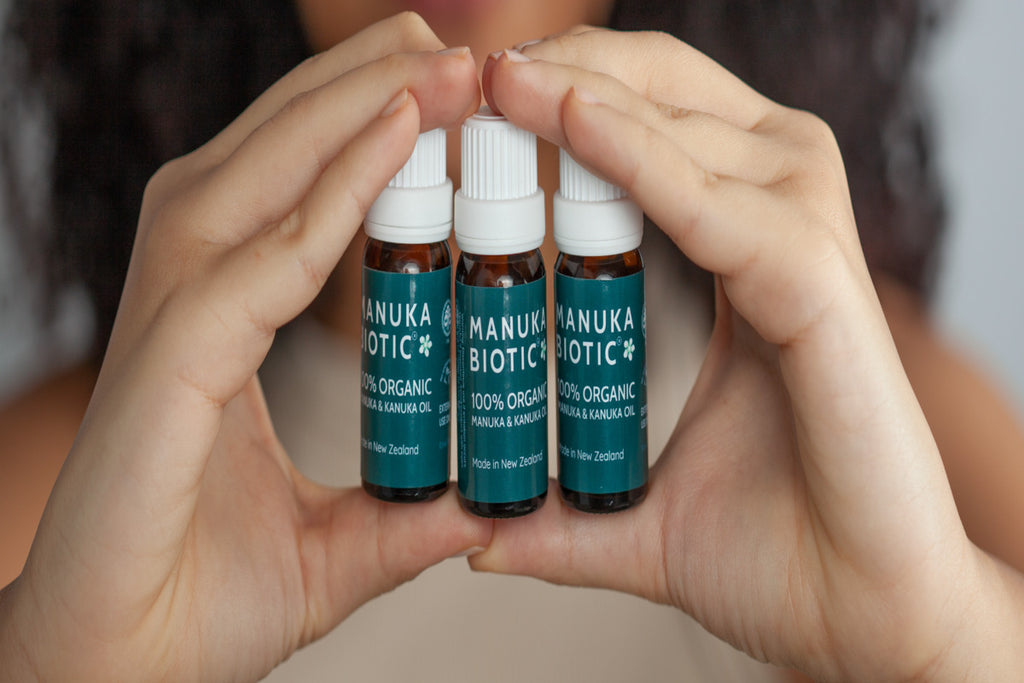Fungal infections can be persistent, affecting various parts of the body, with conditions like athlete's foot and nail infections causing discomfort. In the quest for effective and natural solutions, Mānuka oil emerges as a powerhouse, offering a holistic approach to combat these issues. In this blog, we delve into the wonders of Mānuka oil and how it can be harnessed to treat athlete's foot, nail infections, and more.
Understanding Fungal Infections
Fungal infections, commonly affecting the skin and nails, can be challenging to manage. Athlete's foot, characterised by itchy and peeling skin between toes, and nail infections, causing discolouration and brittleness, are prevalent concerns. Traditional treatments may come with side effects, leading many to explore natural alternatives like Mānuka oil.
The Potency of Mānuka Oil
Mānuka oil stands out for its potent antibacterial, anti-inflammatory, antifungal, antiviral, and antioxidant properties1. These attributes make it a versatile and effective remedy for various skin conditions, particularly fungal infections.
Treating Athlete's Foot with Mānuka Oil
Step 1: Mānuka Oil Foot Soak
Start by preparing a soothing foot soak using certified organic Mānuka oil. Add a few drops of pure Mānuka oil to warm water and immerse your feet for 15-20 minutes. This helps soften the skin, making it more receptive to treatment.
Step 2: Application of Mānuka Oil
After the foot soak, pat your feet dry and apply Mānuka oil directly to the affected areas. Its antifungal properties work to combat the underlying causes of athlete's foot, providing relief from itching and peeling.
Step 3: Overnight Repair with Restorative Hand Cream
Opt for a thick and nourishing cream like Restorative Hand Cream for overnight skin repair. Apply a generous amount to the affected areas, cover with a clean cotton sock, allowing the cream to work its magic while you sleep. The thick consistency ensures deep hydration and promotes healing.
Combating Nail Infections with Mānuka Oil
Step 1: Mānuka Oil Nail Soak
Prepare a Mānuka oil nail soak by adding a few drops to warm water. Soak your affected nails for 15-20 minutes to soften the nails and surrounding skin.
Step 2: Direct Application of Mānuka Oil
Apply pure Mānuka oil directly to the infected nails. Its potent antifungal properties penetrate the nail bed, targeting the infection at its source.
Step 3: Regular Application of Restorative Hand Cream
Consistent application of Restorative Hand Cream on the affected nails and affected areas helps in maintaining moisture and promoting the healing process. The cream's thickness ensures prolonged contact, enhancing its efficacy.
Additional Tips for Fungal Infection Prevention
-
Antibacterial Foot Soaks: Incorporate regular foot soaks in antibacterial solutions to prevent the recurrence of fungal infections.
-
Mānuka Oil Laundry Boost: Add a few drops of pure Mānuka oil to your laundry. Washing socks and footwear in hot water infused with Mānuka oil helps eliminate bacteria, reducing the risk of reinfection.
-
Choose Breathable Footwear: Opt for breathable shoes and socks to create an environment less conducive to fungal growth.
Treating Fungal Infections Naturally
In the realm of natural remedies, Mānuka oil emerges as a formidable solution for combating fungal infections. From athlete's foot to nail infections, its multifaceted properties make it a go-to choice for those seeking effective and holistic care. By incorporating Mānuka oil into your skincare routine and following our detailed steps, you can take significant strides towards healthier and happier feet.
Harness the power of Mānuka oil – your ally in the battle against fungal infections.
SOURCES
1. Maddocks-Jennings, W. et al. (2005) A fresh look at manuka and Kanuka Essential Oils from New Zealand, International Journal of Aromatherapy. No longer published by Elsevier. Available here.
2. Douglas, Malcolm & Klink, John & Smallfield, Bruce & Perry, Nigel & Anderson, Rosemary & Johnstone, Peter & Weavers, Rex. (2004). Essential oils from New Zealand manuka: Triketone and other chemotypes of Leptospermum scoparium. Phytochemistry. 65. 1255-64. 10.1016/j.phytochem.2004.03.019.














